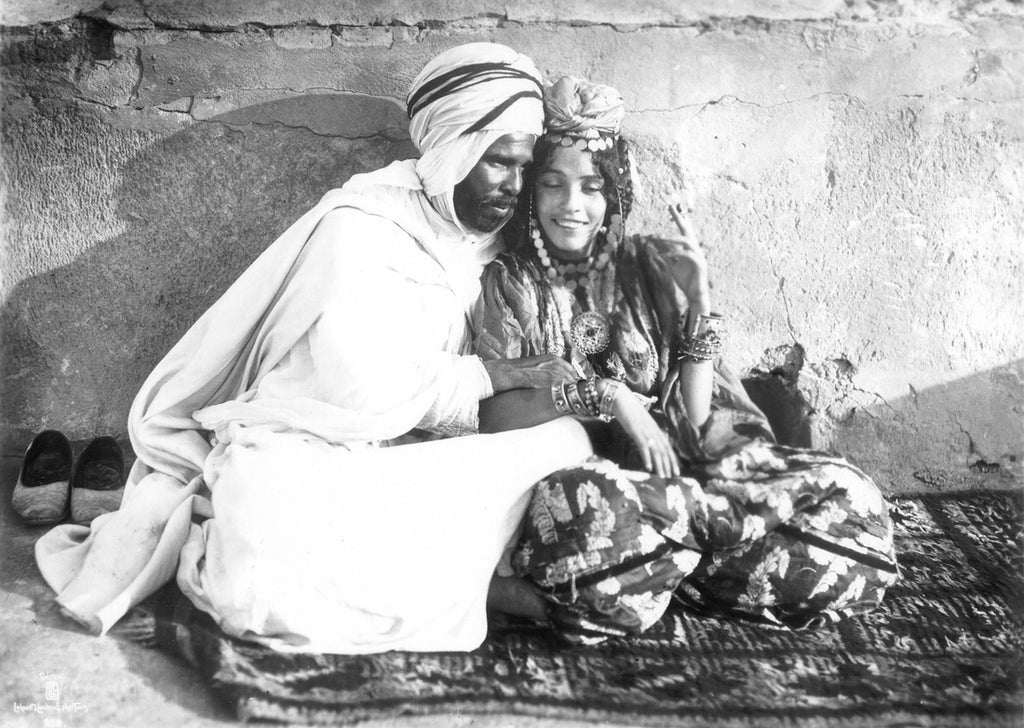Ahmad al-Ghazali: In reality love is affliction

_____________________________
Photo: Couple, Ouled Nail, c. 1910; Lehnert Landrock.
_____________________________
In reality love is affliction. Intimacy and comfort in it are strange and borrowed, since separation in love is really duality and union is really one. The rest is all the imagination of union, not the reality of union. Regarding this it is said:
Love is affliction. I am the one who does not withdraw from affliction. When love is asleep, I stir up evil.
My friends told me to withdraw from affliction.
Affliction is the heart, how can I withdraw from the heart.
The tree of love grows from within the heart. When it needs water, I pour it from the eyes.
(Ahmad al-Ghazzāli; Selections from Sawāniḥ al-ʿushshāq translated for 'Anthology of Philosophy 4' by Joseph Lumbard)
_____________________________
'Three Muslim Sages: Avicenna-Suhrawardi-Ibn Arabi'
By Seyyed Hossein Nasr (Author)
Purchase Book:
Amazon.com
Amazon.co.uk
Description:
While the book title focuses on three Muslim sages, Nasr's intention here is to delineate a particular progression in Islamic knowledge through these three figures. From Avicenna (Ibn Sina) as the exemplar of Islamic Peripatetic Philosophy to Suhrawardi's theosophy and finally to Ibn Arabi's gnosis, we see not only a historical/universal progression, but a kind of microcosmic possibility in the individual as well.
Looked at from a Sufi perspective, we see three progressing levels of awareness in knowledge (hearing of something and believing it), certainty (seeing it) and immersion through direct contemplation or connection. It is possible from another perspective to see these three systems of thought on more of a horizontal plane as representing three different approaches to viewing divinity. Yet that would also require viewing all three systems simply from an intellectual vs. experiential perspective.
Nasr, as a traditionalist/perennialist is big on using symbols as a paradigm, and this is seen in the way he defines theosophy as "neither philosophy nor theology, but a knowledge of the Divine mysteries" (150). In this definition, knowledge becomes certainty short of direct experience, which is then taken up by Arabi's foundational structures of Sufism.
Nasr's focus is on the transcendent reality as expressed through all revealed religions, but in this particular case as culminated in Islam. His effort here is one more in his great corpus of work that embraces all forms of knowledge that have enriched the Islamic tradition. Nasr as a writer has historically encouraged reading "the book of nature" alongside the Qur'an, and to him nature is not just the outdoors, but all available forms of wisdom and experience that enlighten our knowledge of divinity.
By Seyyed Hossein Nasr (Author)
Purchase Book:
Amazon.com
Amazon.co.uk
Description:
While the book title focuses on three Muslim sages, Nasr's intention here is to delineate a particular progression in Islamic knowledge through these three figures. From Avicenna (Ibn Sina) as the exemplar of Islamic Peripatetic Philosophy to Suhrawardi's theosophy and finally to Ibn Arabi's gnosis, we see not only a historical/universal progression, but a kind of microcosmic possibility in the individual as well.
Looked at from a Sufi perspective, we see three progressing levels of awareness in knowledge (hearing of something and believing it), certainty (seeing it) and immersion through direct contemplation or connection. It is possible from another perspective to see these three systems of thought on more of a horizontal plane as representing three different approaches to viewing divinity. Yet that would also require viewing all three systems simply from an intellectual vs. experiential perspective.
Nasr, as a traditionalist/perennialist is big on using symbols as a paradigm, and this is seen in the way he defines theosophy as "neither philosophy nor theology, but a knowledge of the Divine mysteries" (150). In this definition, knowledge becomes certainty short of direct experience, which is then taken up by Arabi's foundational structures of Sufism.
Nasr's focus is on the transcendent reality as expressed through all revealed religions, but in this particular case as culminated in Islam. His effort here is one more in his great corpus of work that embraces all forms of knowledge that have enriched the Islamic tradition. Nasr as a writer has historically encouraged reading "the book of nature" alongside the Qur'an, and to him nature is not just the outdoors, but all available forms of wisdom and experience that enlighten our knowledge of divinity.
_____________________________
_____________________________


Leave a comment